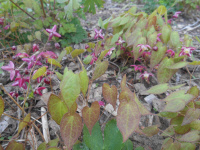Deer Resistant Plants
Showing 57–64 of 155 results
-
Echinacea paradoxa Bush’s coneflower Z 3-9
Sulfur yellow petals droop down below the bristly, dark-chocolate central cone, blooming in early summer
Sulfur yellow petals droop down below the bristly, dark-chocolate central cone, blooming in early summer.
Size: 2-4' x 14"
Care: sun to part shade in moist well-drained soil, drought tolerant
Native: Ozark Mountains of Arkansas and Missouri
Wildlife Value: attracts butterflies. Deer and rabbit resistant.Echinacea is Greek meaning hedgehog referring to the bristly conehead. Paradoxa because yellow petals on a Purple coneflower is a paradox. The first description of this is based on plants collected by B.F. Bush in Swan, Nichols Junction and Eagle Rock Missouri in 1878 and 1898 as well as one collected by German planthunter “Father of Texas Botany” Ferdinand Lindheimer in Texas in 1843. Transactions of the Academy of Science of St. Louis, Vol XII January to December, “Notes on Some Plants of the Southwestern United States” J.B.S. Norton 1902, p. 40.
-
Echinops ritro Globe thistle Z 3-9
Mid to late summer, round, steel blue flower heads at 1st prickly then turning soft and fuzzy. Great cut flower, fresh or dried.
Mid to late summer, round, steel blue flower heads at 1st prickly then turning soft and fuzzy. Great cut flower, fresh or dried.
Size: 3-4' x 18"
Care: Sun in well-drained soil, drought tolerant
Native: Southern Europe
Wildlife Value: attracts American painted lady butterflies, deer resistantThe name Echinops is Greek meaning “like a hedgehog” describing the circular spiny thistles. Introduced to England by 1570. Popular Victorian flower. Cultivated by Washington at Mount Vernon.
-
Epimedium x rubrum syn. Epimedium alpinum var. rubrum Red barrenwort Z 4-8
small, star-shaped, rosey-red flowers dance on the ends of wiry-thin stems
OUT OF STOCK
In mid-spring small, star-shaped, rosey-red flowers dance on the ends of wiry-thin stems about one foot high. Red-flushed foliage follows the flowers, the more sun, the more red on leaves. Wonderful groundcover. Cross between Epimedium grandiflorum and Epimedium alpinum
Size: 16” x 24” slow spreading
Care: Sun to shade in most any soil but best in part shade – one of most adaptable plants
Wildlife Value: deer resistant
Awards: Elisabeth Carey Miller Botanic Garden Great Plant Pick1st described in 1853 in Belgique Hort. iii. 33. I. 6.
-
Eryngium giganteum Miss Wilmott’s ghost SELF-SEEDING BIENNIAL Z 5-8
In summer, oval thistles top prickly green, turning steely blue, silvery, bracts – very ornamental.
In summer, oval thistles top prickly green, turning steely blue, silvery, bracts – very ornamental.
Size: 36" x 24"
Care: Full sun in moist well-drained, fertile soil. Be sure to let it drop its seeds & do not weed seedlings out the following spring.
Native: Caucasus Mountains
Awards: England's Royal Horticultural Society Award of Merit.Eryngium is Greek for thistle. Introduced to England in 1820. Miss Ellen Willmott (1858-1934), a wealthy, eccentric English gardener reputedly dropped seeds as she passed her neighbors’ gardens. The plants came up afterwards, her “ghosts.” Recommended by Gertrude Jekyll in 1908.
-
Eupatorium sessilifolium Upland boneset Z 3-8
Showy flat-topped, white flower clusters July to September
Showy flat-topped, white flower clusters July to September
Size: 3-4’ x 12-24”
Care: Shade to part shade in moist well-drained soil to dry soil, drought tolerant
Native: most of eastern half of US, Wisconsin native but rare and endangered
Wildlife Value: Nectar attracts bees and butterflies. Food for caterpillars of several moths. Deer & rabbit resistant.Collected before 1753.
-
Euphorbia corollata Flowering spurge Z 4-7
Small white flowers (bracts), like a baby's breath but better, July & August. One of the best prairie natives, but slow to mature.
Small white flowers (bracts), like a baby’s breath but better, July & August. One of the best prairie natives but slow to mature.
Size: 36' x 24" spreading slowly
Care: sun in well-drained to moist well-drained soil. Drought resistant.
Native: Canada to Florida and west through the plains, Wisconsin native
Wildlife Value: deer resistant. Its pollen & nectar feed endangered Karner Blue butterfly as well as other small butterflies, numerous bees, wasps and flies. Several birds eat the seeds.A favorite medicine among native Americans. Cherokee rubbed the plant’s juice on skin to cure cancer. Also used to remedy tooth aches and gonorrhea. Winnebago cut a 2.5” long root to clear stomach and steeped leaves for a baby’s colic. According to Breck (1851), “One of the most elegant species peculiar to the United States.”
-
Euphorbia myrsinites Donkeytail spurge Z 5-8
Chartreuse umbels at stem tips contrast succulent blue-gray foliage in early spring
Chartreuse umbels at stem tips contrast succulent blue-gray foliage in early spring
Can not ship to: Colorado.
Size: 4” x 12”
Care: Sun in well-drained soil, drought resistant
Native: Western Asia
Awards: England’s Royal Horticultural Society Award of Garden Merit.Euphorbia was named for Euphorbus, physician of Numibian King Juba, father of Ptolemy (c. 50 B.C. – 20 A.D.) Reputedly Euphorbus used spurge to remedy the King’s enlarged stomach. Euphorbus’ brother was Augustus Caesar’s physician. Myrsinites is a Greek word meaning “resembling myrtle.” This plant described by Swiss botanical scholar Conrad Gesner in his book Horti Germaniae published in 1541.
-
Euphorbia polychroma Cushion spurge syn. Euphorbia epithymoides Z 4-9
May - June flashy chartreuse flowers. In fall foliage turns orangey-red.
OUT OF STOCK
May – June flashy chartreuse flowers. In fall foliage turns orangey-red.
Size: 16" x 24"
Care: Sun, moist well-drained humusy soil. Drought tolerant.
Native: Central and Southern Europe
Awards: England's Royal Horticultural Society Award of Garden Merit.Polychroma means many colors referring to the fact that the plant changes colors with yellow-chartreuse flowers in spring and red foliage in fall. Named and described by Swedish botanist Linnaeus 1753.








